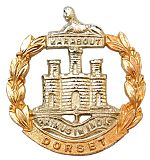- Dorset Regiment
-
The Dorset Regiment 
Badge of the Dorset Regiment (1953-1958)Active 1881-1958 Country United Kingdom Branch  Army
ArmyType Infantry Role Line Infantry Size 2 Regular Battalions
1 Reserve Battalion
1 Territorial BattalionGarrison/HQ Dorchester Nickname The Dorsets Motto Primus in Indis March Quick: The Maid of Glenconnel Anniversaries Plassey, 23 June The Dorset Regiment was an infantry regiment of the British Army from 1881 to 1958, the county regiment of Dorset. Until 1951 it was formally called The Dorsetshire Regiment, although usually known as "The Dorsets".
Contents
History
The Dorsetshire Regiment was formed in 1881 under the Childers Reforms by the amalgamation of the 39th (Dorsetshire) Regiment of Foot and the 54th (West Norfolk) Regiment of Foot.[1]
The 1st Battalion took part in operations on the North West Frontier of India in 1897-98 and the 2nd Battalion fought in the Second Boer War, participating in the Relief of Ladysmith.
During the Great War, nine hostilities-only battalions were formed, six battalions serving overseas. The 1st and 6th Battalions served on the Western Front throughout the war.[2] The 2nd Battalion was in Poona, India, when war broke out and was shipped to Mesopotamia where it was trapped in the Siege of Kut and captured by the Turks. (Of the 350 men of the battalion captured, only 70 survived their captivity.) During the siege, returning sick and wounded, and the few replacements who were sent out, were unable to re-join their battalion, so they, and similar drafts of the 2nd Battalion, The Norfolk Regiment, were amalgamated into a scratch battalion forming part of the force attempting to relieve Kut.[3] This battalion was formally titled the Composite English Battalion, but was more commonly known as The Norsets, and was broken up in July, 1916, when the 2nd Dorsets was re-constituted. 1/4 Battalion served in India and Mesopotamia and 1/5 Battalion in India and Egypt and Palestine. The 5th Battalion fought at Gallipoli, Egypt and Palestine, and the Western Front.
In 1921, the 2nd Battalion was in India and helped put down the Moplah Rebellion. It was stationed in Palestine in 1936 to 1939, at the time of the Arab revolt.
In the Second World War, eight hostilities-only battalions were raised. The 1st Battalion was part of 231st Infantry Brigade for the duration of the war, fighting in Malta, Sicily, and Italy. It landed on Gold Beach on D-Day and fought with the Brigade in the Battle of Normandy and North-West Europe. The 2nd Battalion was part of 5th Infantry Brigade throughout the war, participating in the Battle of France and the Dunkirk evacuation in 1940. In 1944, it took part in the Burma Campaign of 1944-1945 and the Battle of Kohima. The 4th and 5th Battalions fought in the liberation of Northwest Europe in 1944-1945. The 30th Battalion was with 43rd Infantry Brigade in North Africa and the invasion of Sicily, after which it spent the rest of the war in Gibraltar.
In 1958 the regiment amalgamated with The Devonshire Regiment to form the Devonshire and Dorset Regiment.
Battle honours
The regiment was awarded the following battle honours. Those from the two World Wars that are emblazoned on the Queen's Colour are indicated in bold:
- From 39th Regiment of Foot: Plassey, Gibraltar 1779-83, Albuhera, Vittoria, Pyrenees, Nivelle, Nive, Orthes, Peninsula, Maharajpore, Sevastopol
- From 54th Regiment of Foot: Marabout, Egypt, Ava
- Martinique 1794 (awarded in 1909 for service of the 39th Regiment), Tirah, Relief of Ladysmith, South Africa 1899-1902
- The Great War (13 battalions): Mons, Le Cateau, Retreat from Mons, Marne 1914, Aisne 1914, La Bassée 1914, Armentières 1914, Ypres 1915 '17, Gravenstafel, St. Julien, Bellewaarde, Somme 1916 '18, Albert 1916 '18, Flers-Courcelette, Thiepval, Ancre 1916 '18, Arras 1917, Scarpe 1917, Messines 1917, Langemarck 1917, Polygon Wood, Broodseinde, Poelcappelle, Passchendaele, St. Quentin, Amiens, Bapaume 1918, Hindenburg Line, Épéhy, Canal du Nord, St. Quentin Canal, Beaurevoir, Cambrai 1918, Selle, Sambre, France and Flanders 1914-18, Suvla, Landing at Suvla, Scimitar Hill, Gallipoli 1915, Egypt 1916, Gaza, El Mughar, Nebi Samwil, Jerusalem, Tell 'Asur, Megiddo, Sharon, Palestine 1917-18, Basra, Shaiba, Kut al Amara 1915 '17, Ctesiphon, Defence of Kut al Amara, Baghdad, Khan Baghdadi, Mesopotamia 1914-18
- The Second World War: St. Omer-La Bassée, Normandy Landing, Villers Bocage, Tilly sur Seulles, Caen, Mont Pincon, St. Pierre La Vielle, Arnhem 1944, Aam, Geilenkirchen, Goch, Rhine, Twente Canal, North-West Europe 1940 '44-45, Landing in Sicily, Agira, Regalbuto, Sicily 1943, Landing at Porto San Venere, Italy 1943, Malta 1940-42, Kohima, Mandalay, Mt. Popa, Burma 1944-45
Victoria Cross
The following member of the regiment was awarded the Victoria Cross:
- Private (later Corporal) Samuel Vickery, Tirah Campaign
References
Categories:- Infantry regiments of the British Army
- Military history of Dorset
- Military units and formations established in 1881
- Regiments of the British Army in World War II
- Regiments of the British Army in World War I
- Military units and formations disestablished in 1958
- Dorset Regiment
- 1881 establishments in the United Kingdom
Wikimedia Foundation. 2010.
